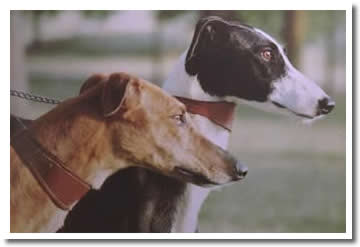
The Galgo Español (Spanish hound) really took form in the middle ages. As the reconquest of Spain advanced, previously abandoned lands began to regain lost Christian populations and kings began to assert their power and influence. |
 |
|
|
Some photographs courtesy Michelle Henninger There are three recognized types of Spanish Hound: The smooth-haired variety, the long-haired variety (almost non-existant) and the hard-haired variety. Of the three, the first is the most frequently seen at the dog shows, field tests and the competitions that take place at the dog tracks.
|
 |
|
The hare became very commonplace in the sowing lands and extensive areas of wasteland and fallow land brought about an increase in game, thus consolidating the traditional hare races with Spanish Galgo, a common practice as much in the arab kingdoms as in the Christian ones. |
|
|
There
is proof as to how much the Greyhound was appreciated at this time due
to the great number of laws that penalized their being stolen or being
killed. The municipal charters of Salamanca (9th century), Cuenca, Zorita
de los Canes, Molina de Aragón (12th century) and Usagre (10th
century) bear witness to this in the archives of Slonza. There are records
of a donation of landed property being made by Gutierrez in favour of
Diego Citid, dated the 3rd november 1081, in which the following statement
can be read: "Urso Galgo colore nigro valente caetum solidos dae
argento". To find this type of dog listed gives us an idea of
how highly it was appreciated.
|
|
|
|
In
the renaissance the Spanish Hound tradition continued to flourish and
thus Martinez del Espinar writes in this book "The art of crossbowmanship
and hunting: there are many ways to kill these animals (the hares). I
would say that in Spain they chase them with hounds which are extremely
lightweight here as some of the hares which escape without being caught
however, just because they are fleeing doesn´t mean they don´t
return to their owners; the hares continue because they know the trail
and in most cases they hide near the waybys, on the edge of some thicket,
mountain or hillside or stony ground and thus escape and go downhill however
the Spanish Hounds reached them on the hillsides and rough ground and
seem to fly..."
|
|
The
names "Galgo" and "Lebrel" are nowadays treated as
synonyms which refers to the same race of dog; however there is documentation
that demonstrates that in the 14th Century the "Lebrel" was
of a medium size, with a fairly large and long head, a bulky stomach and
powerful flanks as can be read in the book on hunting by Gaston Phoebus.
As time passed, the Spanish Hound developed its morphology, and at the
same time it was progressively referred to as "Lebrel" or "Galgo"
indistinctly.
|
|
|
|
|